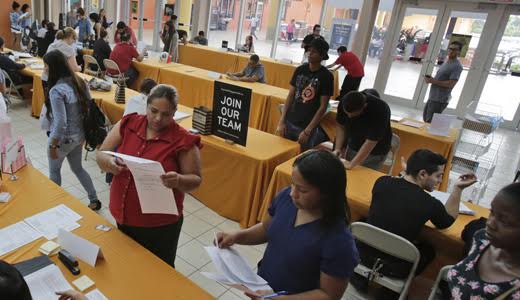
WASHINGTON (PAI) – The nation’s unemployment rate rose by 0.2 percent in June to 4.9 percent, the Bureau of Labor Statistics reported. Private businesses claimed to create 265,000 new jobs last month, while governments added 22,000 more, a separate survey said.
The mixed message continued in other data from BLS:
- The number of jobless rose by 347,000, to 7.783 million, while the number of people not in the workforce dropped by almost 200,000.
- Almost 40,000 of the new jobs were not created, but re-created, as the Communications Workers and the Electrical Workers returned on June 1 from Verizon’s forced 45-day strike. The telecom sector added 28,100 jobs, net, rising to 797,900 total. Only low-paying health care (+38,500 jobs) and retail (+29,900) added more.
- High paying sectors that added jobs included the telecom workers and government workers, especially in local government and schools (+17,000 combined). Factories added 14,000 jobs, to 12.296 million, but virtually of them – 13,000 — were in one of the lowest-paying areas of a high-paying sector, food plants.
- Meanwhile, at the height of construction season, there was literally no employment change at all, with 6.643 million employed building trades workers in both May and June. Jobless rates were 4.6 percent in construction and 3.7 percent in factories.
- Almost one in ten workers (9.6 percent) were jobless, underemployed – people forced to toil part-time when they really want full-time work-or so discouraged they stopped looking. That percentage has changed little in the last five months.
- And 25.8 percent of all jobless workers in June had been out of work for more than six months, meaning they’ve exhausted their jobless benefits. That’s up from 25.1 percent in May.
- Unemployment rates for major demographic groups changed little, except for African-American teenagers. Their number jumped by 33,000 from May to June, to 228,000, and their joblessness rose from 27.1 percent in May – already the highest rate – to 31.2 percent in June.
Pro-worker analysts’ reactions were mixed, too. Dean Baker of the Center for Economic and Policy Research worried about the jobless hike among African-American teens. “These data are highly erratic, but the trend is large enough that it could reflect a substantial deterioration in the labor market,” he said.
Elise Gould of the Economic Policy Institute concentrated on “missing workers” – the ones forced to toil part-time or who have dropped out. As a result, the jobless rate “drastically understates the weakness of job opportunities,” she said. If you add the 2.63 million missing workers to the official jobless numbers, the June jobless rate would be 6.4 percent, she pointed out. EPI data show that at the height of the Great Recession – also known as the Bush Crash-in early 2010, that recalculated rate hit 19.9 percent.
Photo: At a job fair in Miami. Wilfredo Lee | AP










